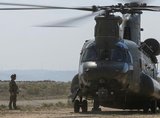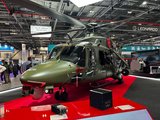Ukraine lessons: is bringing an attack helicopter to a missile fight too dangerous?
The relatively lightly armoured Ka-52 has proved particularly vulnerable to Ukraine’s highly mobile air defences. (Photo: Rosoboronexport)
The absolute number of helicopters downed or written off amounts to possibly 10% of the Russian operational fleet, but as these are likely more advanced variants flown by better crews, that remains a significant dent in capability. Interestingly, it is the relatively modern Ka-52 model that forms the bulk of these losses.
The reasons for this experience, and how the situation has evolved, are of interest to other operators keen to draw lessons on their own approach to rotary-wing operations, especially as the US and others are accelerating new helicopter development.
Why has Russia lost so many helicopters in Ukraine?
Already have an account? Log in
Want to keep reading this article?
More from DSEI 2023 | View all news
-
![Orbiting the Future: How New Satellite Technologies are Revolutionising Global Communications]()
Orbiting the Future: How New Satellite Technologies are Revolutionising Global Communications
With the satellite industry at a pivotal juncture, Intelsat is investing in advanced technologies like 5G and optical communications, striving to enhance worldwide connectivity and address emerging governmental needs.
-
![CH-47 Chinook: why the timeless helicopter design is still a heavy-lift contender on the modern battlefield]()
CH-47 Chinook: why the timeless helicopter design is still a heavy-lift contender on the modern battlefield
From its emergence as a ground-breaking design in the 1950s to its widespread deployment in diverse operations worldwide, the Chinook continues to leave an indelible mark on the aviation landscape. Shephard sums up the latest developments and tells you everything you need to know about the workhorse of many armies and air forces in the 2020s.
-
DSEI 2023: Controp unveils Smart Vision AI software for EO/IR payloads
Controp Precision Technologies unveiled its Smart Vision AI software for enhancing the level of autonomy and automation for a variety of surveillance and reconnaissance missions at DSEI 2023.
-
![Babcock and Cosworth to test hybrid propulsion in militarised Land Cruiser 70]()
Babcock and Cosworth to test hybrid propulsion in militarised Land Cruiser 70
Babcock has signed an MoU with propulsion experts Cosworth to investigate the use of hybrid power systems in military vehicles and will begin with integrating a Catalytic Generator (Cat Gen) into a 70 Series Toyota Land Cruiser.
-
![DSEI 2023 in review: Ukraine, AI and the real world]()
DSEI 2023 in review: Ukraine, AI and the real world
DSEI 2023 took place in the shadow of the largest European land war in more than seven decades and a growth in conversations about artificial intelligence (AI) with limited UK immediate defence programme opportunities; many of the new products and exhibitors' announcements reflected this.
-
![DSEI 2023: SpearUAV rolls out drone launcher system for submarines]()
DSEI 2023: SpearUAV rolls out drone launcher system for submarines
Israeli UAS developer SpearUAV introduced a submarine-launched capsule option for its Viper 750 UAV at DSEI 2023.






















